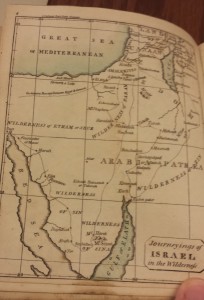
A map of “Journeyings of Israel in the Wilderness”
An atlas provides the physical and geographical context to stories. The OED defines the word “atlas, n.” as “A collection of maps in a volume. [This use of the word is said to be derived from a representation of Atlas supporting the heavens placed as a frontispiece to early works of this kind, and to have been first used by Mercator in the 16th cent.]” The 1819 Bible Atlas is only 9 maps, but it serves as a chapbook experience of an atlas collection.
“Settings of Stories
Those who tell stories often set them in a particular time and place. In some works of fiction, where the setting too is entirely fictional, a map is provided to help the readers to follow the story; for example, with J. R. R. Tolkien’s trilogy The Lord of the Rings comes a map of ‘Middle Earth’, the setting of the saga. Writers of historical novels are often at great pains to provide an accurate geographical setting, perhaps with a map, even if the contents are primarily fictional. And those who seek to recount the stories of real people and events do so with reference to the locations of the activities described. Therefore it is important for the readers of stories to have an awareness of their geographical setting. This is not simply to enable the reader to plot movement from place to place. The reader may be helped to know whether the setting is in a desert or in a forest, in a frozen waste or in the tropics, in a bustling city or an idyllic rural setting. So an appreciation of the setting may help the understanding of the story. If this is true of other types of literature, it is certainly true of the Bible.” (Curtis)

Map of “Israel, Showing those Places which are mentioned by the FOUR EVANGELISTS”
The 1819 Bible Atlas was produced for primarily North American readers who likely had very limited access to other varieties of scriptural maps, and therefore may not have had any concept of what the geography of these stories was like. As Curtis says in the passage above from the Oxford Bible Atlas, an atlas helps a reader to connect with the text more deeply, as they then understand the location and setting of what they are reading, making it easier to submerse the reader in the experience.
Curtis, Adrian. Oxford Bible Atlas, 4th ed. Oxford, GB: OUP Oxford, 2007. Web.